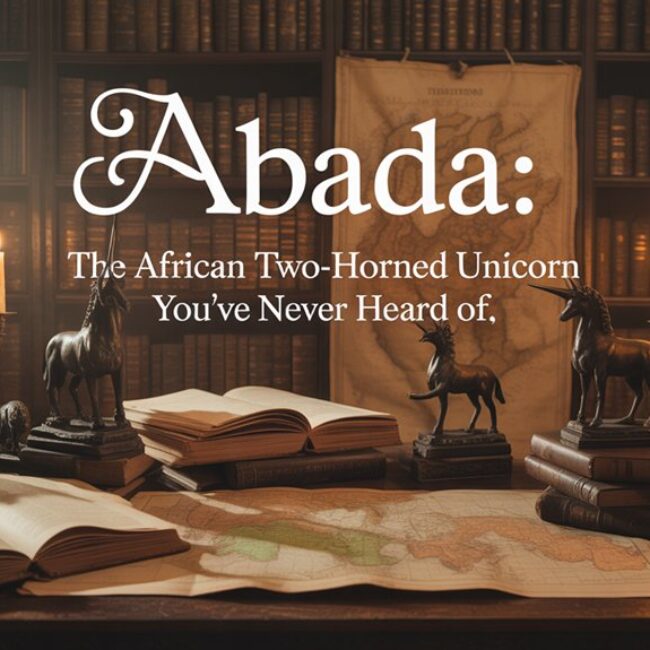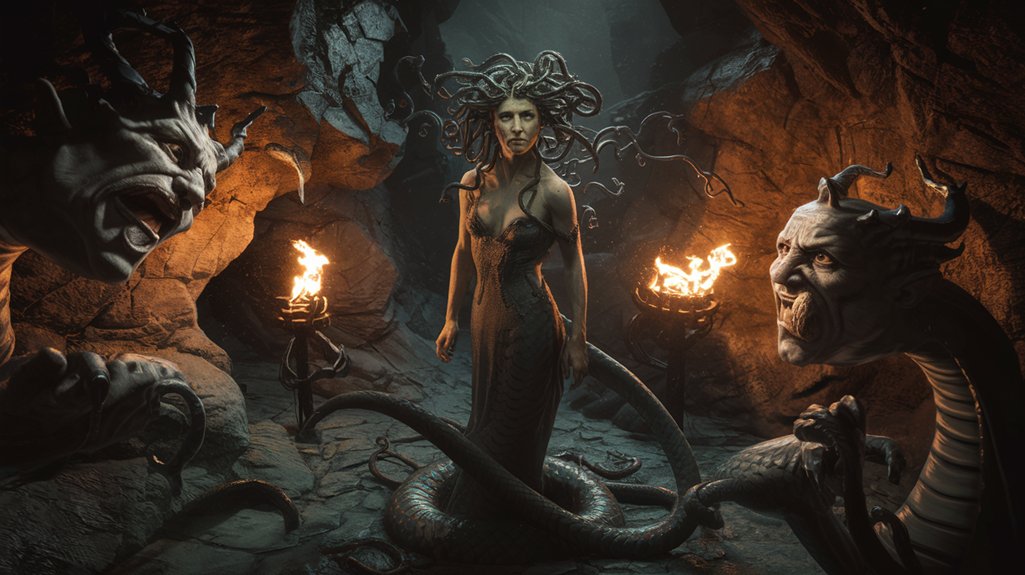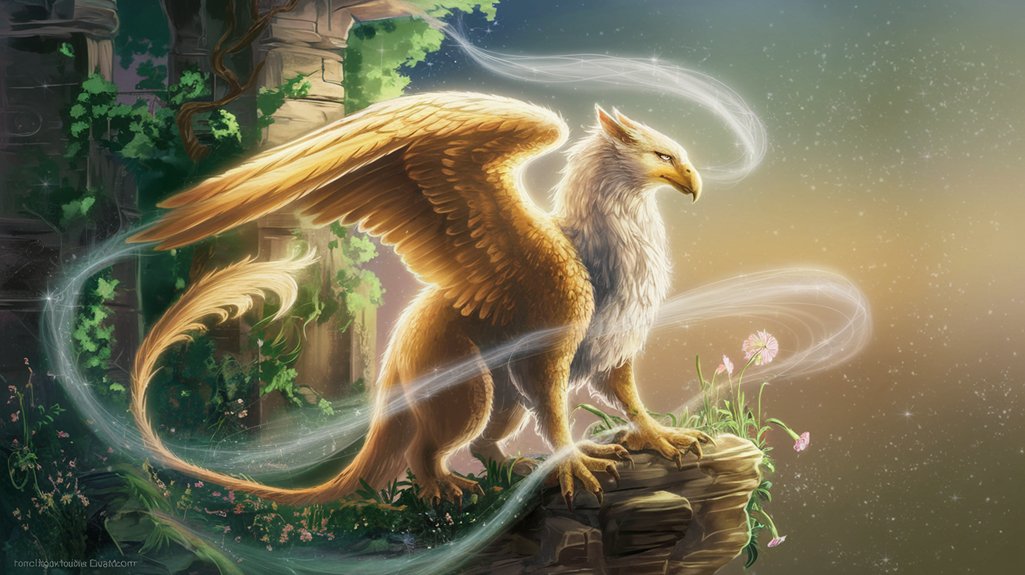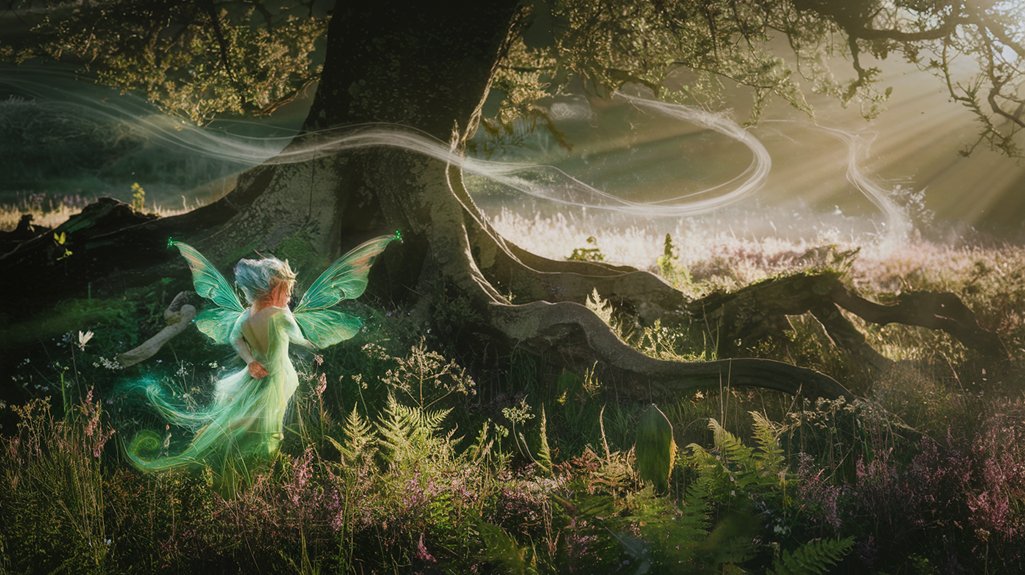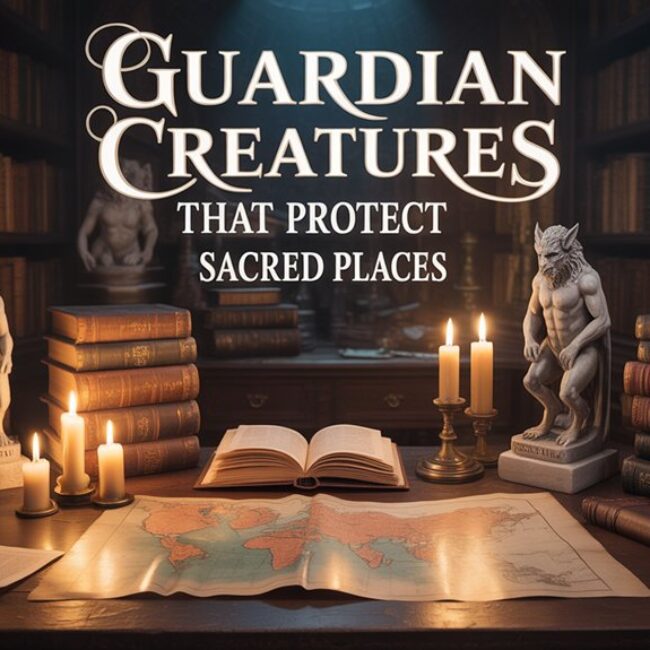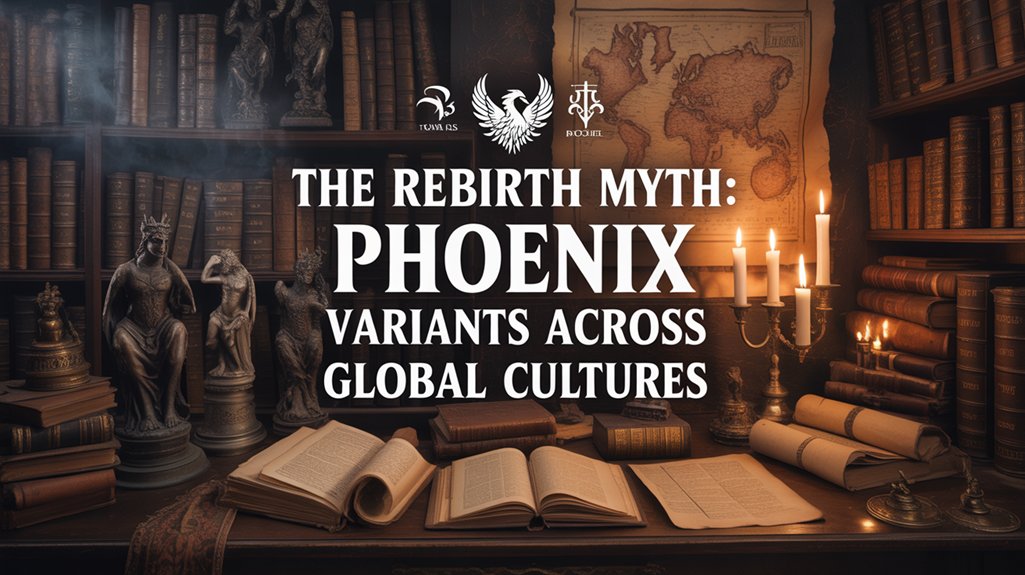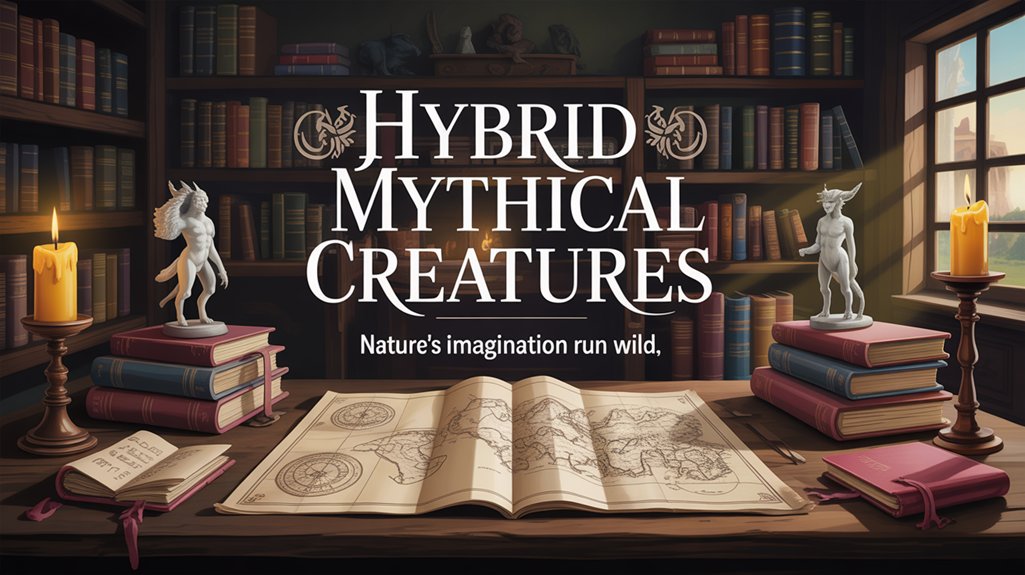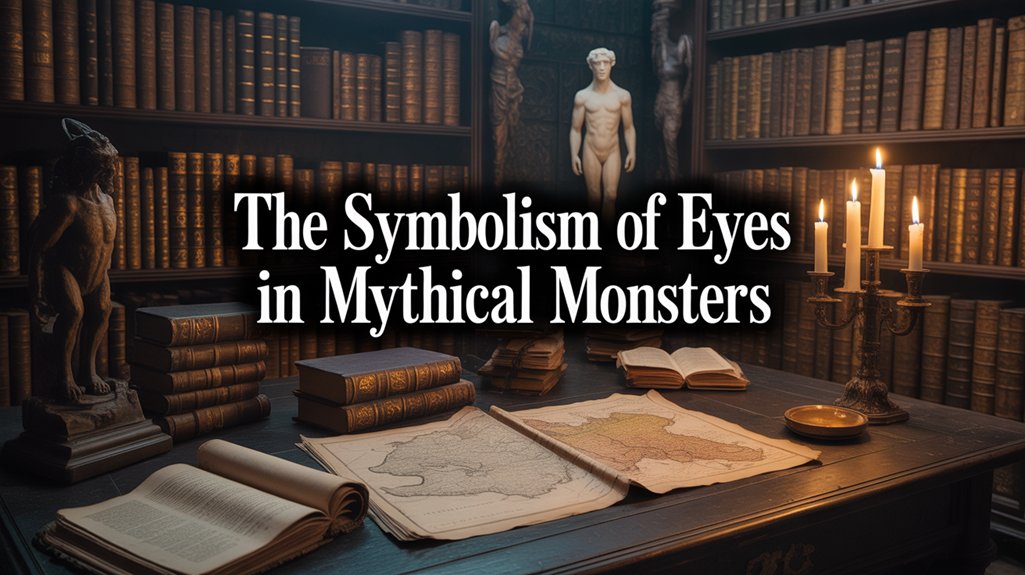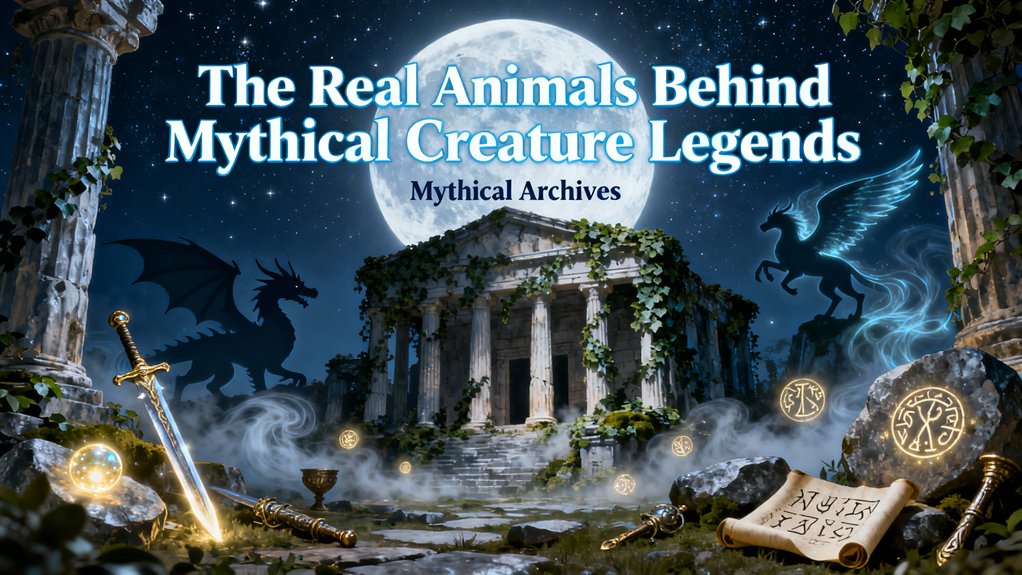
You’ve inherited dragon myths from Mamenchisaurus vertebrae discovered in Sichuan Basin, unicorn legends from rhinoceros descriptions and narwhal tusks traded as alicorn, mermaid sightings born of manatees (*Trichechus manatus*) glimpsed by exhausted sailors, and griffin tales emerging from Protoceratops fossils unearthed by Scythian gold-miners. Basilisk mythology stems from hooded cobra encounters in Egyptian deserts, while oarfish (*Regalecus glesne*) stretching thirty feet inspired sea serpent lore. Phoenix narratives crystallized around flamingo aggregations and peacock plumage across Persian empires. These alterations reveal how ancient observers translated tangible biological phenomena into numinous mythology—each creature mapping precisely onto misidentified fossils, exotic specimens, and environmental conditions that await your examination.
Table of Contents
Toggle🔮 Enhance Your Practice With These Essentials
Chosen for ritual alignment and energetic correspondence.
Key Takeaways
- Dragon legends originated from dinosaur fossils like sauropod vertebrae and observations of monitor lizards such as Komodo dragons.
- Unicorn myths derived from rhinoceros descriptions and narwhal tusks traded as “unicorn horns” in medieval European markets.
- Mermaid sightings resulted from sailors mistaking manatees for human-like creatures during long voyages at sea.
- Griffin mythology emerged from Protoceratops fossils discovered by Scythian gold-miners, featuring beaked quadrupedal skeletal remains.
- Cyclops legends stemmed from dwarf elephant skulls whose central nasal cavity resembled a single eye socket.
Dragons: Ancient Encounters With Dinosaur Fossils and Monitor Lizards

When paleolithic humans first unearthed the massive, serpentine skeletons embedded in limestone cliffs and riverbanks, they possessed no framework for understanding these ossified leviathans—yet the bones demanded explanation.
🎯 Recommended Products
Handpicked items related to this article:
As an Amazon Associate, we earn from qualifying purchases.
Ancient bones surfaced without context, their immensity defying comprehension—yet these fossilized giants compelled our ancestors to construct meaning from mystery.
You’ll find dragon legends emerging precisely where dinosaur discoveries clustered: China’s Sichuan Basin, Mongolia’s Gobi Desert, Europe’s chalk formations. These weren’t mere fantasies.
Ancient myths crystallized around tangible evidence—megalosaurid femurs, sauropod vertebrae, pterosaur wings fossilized in sedimentary strata. The Chinese 龍 (lóng) echoes the elongated spines of Mamenchisaurus, discovered in regions where dragon worship originated millennia before formal paleontology.
Living counterparts reinforced these eldritch visions. The monitor lizard, particularly Varanus komodoensis, embodied chimeric dread: forked tongue tasting air, serrated teeth delivering septic wounds, throat-pouch inflation suggesting fire.
Southeast Asian communities observed these apex predators and wove their attributes into ancestral narratives.
Bones whispered. Lizards demonstrated. Dragons materialized where empirical observation met mythopoeic necessity—humanity’s attempt to taxonomize the numinous and prehistoric simultaneously.
Unicorns: The Rhinoceros Connection and Narwhal Tusks
You’ve encountered unicorn legends not as pure fantasy, but as chimeric amalgamations born from two distinct historical sources: the eldritch accounts of Asian rhinoceroses reaching Mediterranean courts through Persian and Indian trade routes, their single horns inspiring classical descriptions by Ctesias in 398 BCE, and the mysterious spiral tusks of narwhals—those Arctic cetaceans whose ivory appendages flooded medieval European markets as “unicorn horns,” commanding prices exceeding gold.
These convergent misidentifications created a creature simultaneously real and imagined. The rhinoceros provided the terrestrial body, the narwhal furnished the sacred horn, and human longing completed the alteration into myth.
Ancient Rhinoceros Traveler Tales
Though medieval European courts prized spiraled “unicorn horns” as antidotes to poison and symbols of divine purity, these treasured artifacts derived not from mythical equines but from narwhals—Arctic cetaceans whose elongated tusks traveled southward through Norse and Venetian trading networks.
You’ll discover how rhinoceros legends emerged from prehistoric travelers encountering these armored beasts across Asian steppes and African savannas, their accounts converting terrestrial creatures into chimeric marvels.
When Marco Polo documented Indian rhinoceroses in 1298, he shattered illusions—describing horned behemoths nothing like the delicate, horse-like unicorns illuminating manuscript margins. Yet this cognitive dissonance liberated imagination rather than constrained it.
These eldritch encounters between wanderers and megafauna created mythological syncretism, where observed reality merged with cultural expectation, birthing legends that transcended mere zoological documentation to become sacred narratives embodying humanity’s eternal fascination with nature’s untamed mysteries.
Narwhal Tusks in Medieval Europe
Before narwhal tusks reached European shores, they’d already traversed thousands of nautical miles through Greenlandic Inuit hunters who harvested these spiraled protrusions from frigid Arctic waters—maritime treasures that entered medieval consciousness not as cetacean dentition but as tangible proof of unicorn existence. Medieval trade routes altered these eldritch specimens into pharmaceutical commodities worth ten times their weight in gold.
| Narwhal Habitat Reality | European Interpretation |
|---|---|
| Arctic waters, depths to 1,500 meters | Enchanted terrestrial domains |
| Monodontidae family cetacean | Chimeric horse-like beast |
| Male tooth elongation | Horn of purification power |
You’ll find that Nordic merchants weaponized geographical ignorance, selling tusks as alicorn—substances believed to neutralize poison, cure plague, extend life itself. Pure commerce masquerading as mysticism.
Mermaids: Manatees, Dugongs, and Sea-Weary Sailors
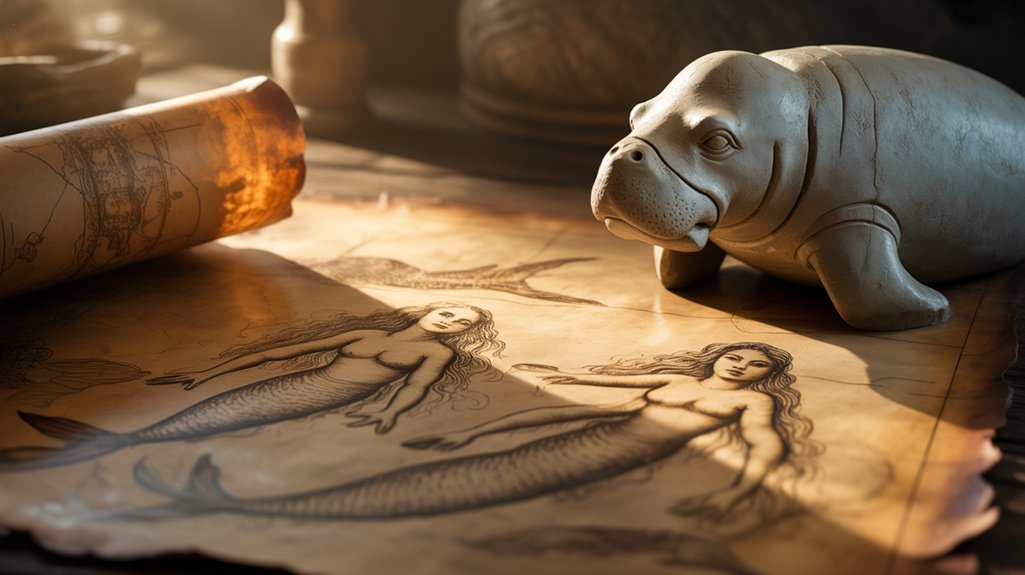
You might wonder how seafarers, steering through the eldritch vastness of uncharted waters for months without glimpsing land, came to mistake the rotund, whiskered manatee for the chimeric beauty of classical mermaids—yet historical accounts from the 15th through 18th centuries document precisely such alterations of perception.
The physiological reality of Trichechus manatus and its Indo-Pacific cousin Dugong dugon reveals creatures whose pectoral fins, nursing behaviors, and vertical tail movements could suggest, to exhausted sailors subsisting on hardtack and rum, something disturbingly anthropomorphic rising from the depths.
Christopher Columbus himself recorded mermaid sightings off Hispaniola in January 1493, noting with disappointment that they were “not as beautiful as depicted,” a revelation that speaks less to the creatures’ appearance than to the powerful intersection of maritime isolation, cultural expectation, and the brain’s tendency to pattern-match the unfamiliar into the legendary.
Mistaken Identity at Sea
The crystalline waters of the Caribbean in 1493 bore witness to Christopher Columbus’s startled notation in his ship’s log: three “mermaids” had surfaced near his vessel, though he remarked with evident disappointment that they were “not as beautiful as they’re painted.
What the Genoese navigator encountered were, in fact, manatees—slow-moving sirenians whose rotund bodies, paddle-like flippers, and habit of nursing their young while vertical in the water created fleeting, fog-shrouded tableaux that exhausted sailors, their minds addled by scurvy and months of isolation, could change into the elusive marine women of Greco-Roman tradition.
You’ll discover how mythical sailors altered mundane encounters into oceanic folklore through:
- Vitamin deficiency-induced hallucinations during extended voyages
- Twilight conditions obscuring anatomical reality
- Cultural pre-conditioning toward chimeric expectations
- Desperate longing for feminine presence
- Salt-spray and distance creating eldritch ambiguity
Manatee Physical Characteristics Explained
Sirenians—those bulbous, herbivorous mammals who drift through shallow coastal waters with prehistoric languor—possess anatomical features that bridge the uncanny valley between beast and imagined human-mer hybrid.
*Trichechus manatus*, the West Indian manatee Columbus encountered, stretches ten to thirteen feet in length and weighs upward of twelve hundred pounds, its gray-brown hide scarred by boat propellers and barnacle colonies, wrinkled as ancient parchment left too long in salt air.
You’ll find their manatee habitat encompasses estuaries, rivers, and warm coastal shallows where seagrass meadows flourish.
Their manatee behavior reveals chimeric qualities: prehensile lips manipulating vegetation like fingers, vestigial nails on paddle-shaped flippers suggesting terrestrial ancestry, horizontal tail flukes propelling them through murk.
At distance, through salt spray and exhaustion, their breaching forms become eldritch women. The misidentification feels inevitable.
Historical Mermaid Sighting Accounts
When Christopher Columbus logged his January 9, 1493 entry off the coast of Hispaniola—documenting three “female forms” rising from the waves, though “not as beautiful as they’re painted”—he inscribed into maritime record what countless sailors before him had whispered in port taverns: sirenas inhabited these waters.
You’ll discover these historical accounts reveal something profound: freedom from landbound existence, reimagined through exhausted minds encountering placid manatees.
Notable historical accounts and cultural interpretations:
- Henry Hudson’s 1608 Arctic expedition recorded “eldritch” creatures with women’s breasts, fish tails
- Pliny the Elder’s Naturalis Historia documented Nereids in Mediterranean waters
- Blackbeard’s crew demanded hazard compensation after chimeric sightings, 1717
- Japanese ningyo legends predate European accounts by millennia
- Babylonian Oannes merged aquatic divinity with human consciousness
These maritime testimonies transcend mere misidentification. Greek mythology cataloged these sea-dwelling figures among various fabulous creatures that populated ancient imagination and classical art.
The Kraken: Giant Squid Encounters in Deep Waters

Beneath tempestuous Nordic seas where sunlight dissolves into impenetrable darkness, sailors of the thirteenth century first chronicled encounters with what they termed *hafgufa*—a creature so vast that mariners mistook its barnacled back for an island chain until the waters began to churn.
You’ll find these deep sea encounters meticulously recorded in Iceland’s *Konungs skuggsjá* (King’s Mirror), where scribes documented tentacled leviathans capable of dragging warships into abyssal trenches.
The kraken wasn’t chimeric fantasy but misunderstood reality: *Architeuthis dux*, the giant squid, whose eldritch form reaches forty-three feet, possesses eyes the size of dinner plates—adaptations for hunting in lightless depths.
Giant squid behavior remained cryptic until 2004, when Japanese researchers captured footage of these cephalopods attacking prey with calculated ferocity.
You’re witnessing mythology’s metamorphosis into marine biology, where ancient terror becomes scientific marvel.
These creatures don’t surrender their secrets easily; they inhabit pressure-crushed domains where human vessels rarely venture, maintaining their liminal existence between legend and documentation.
Griffins: Protoceratops Skeletons Along the Silk Road
Across the wind-scoured plateaus of the Gobi Desert, where Scythian gold-miners excavated precious metals during the seventh century BCE, nomadic prospectors unearthed skeletal remains that defied taxonomic categorization—quadrupedal frames crowned with prominent beaks, suggesting creatures neither wholly avian nor terrestrial.
You’ll discover how Protoceratops fossils, scattered along ancient Silk Road trade routes, gave rise to the chimeric griffin legend. These eldritch remains possessed anatomical features that appeared deliberately monstrous to untrained eyes.
Consider the evidence binding myth to paleontology:
- Beaked skulls resembling raptor heads
- Four-legged skeletal structures suggesting mammalian bodies
- Shoulder blade formations interpreted as wing attachments
- Strategic fossil deposits near gold-bearing geological strata
- Trade networks disseminating hybrid creature narratives westward
The griffin emerged where commerce intersected curiosity. Merchants traveling established Silk Road trade pathways carried tales of these bone-creatures, altering scientific specimens into guardians of treasure.
Reality birthed mythology through misinterpretation.
Cyclops: Elephant Skulls and Misinterpreted Anatomy
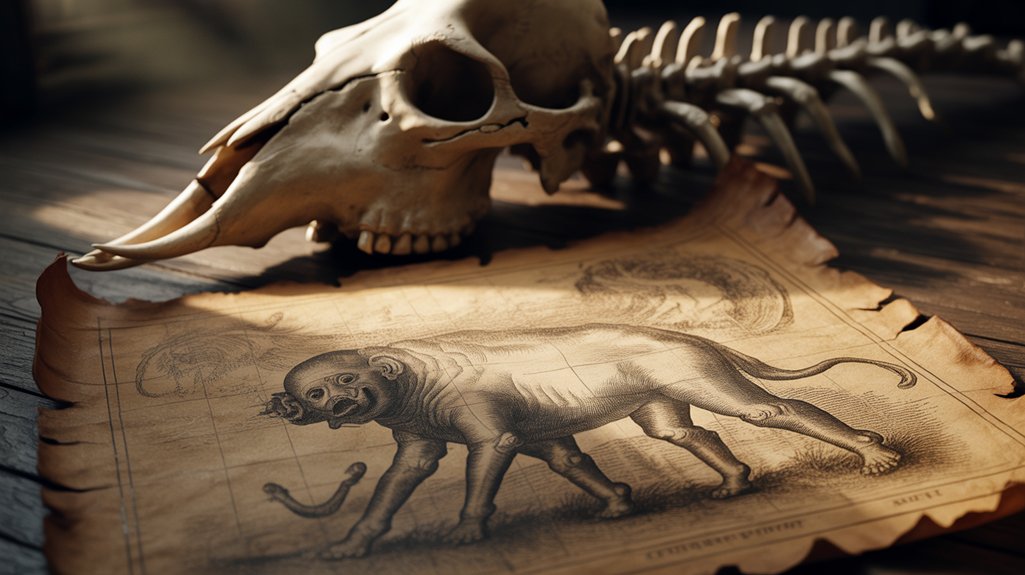
Similar osseous misreadings plagued Mediterranean antiquity, where dwarf elephant skulls (*Elephas falconeri*) littered Sicilian caverns and Cycladic islands—compact cranial vaults measuring merely one meter in length, their nasal cavities gaping centrally like singular orbital sockets.
You’d mistake that aperture for a monstrous eye too, confronting bleached bone in torchlight’s eldritch glow. Ancient Greeks, discovering these chimeric remains without paleontological framework, wove Cyclops mythology from anatomical misinterpretation.
The nasal opening dominated each skull’s facade, positioned precisely where Homer’s man-eating giants bore their terrible vision. No evolutionary context existed. No comparative anatomy guided interpretation.
Mediterranean seafarers stumbled upon these cryptic bones and constructed Polyphemus, constructed bronze-age terror incarnate. Elephant skulls became proof of titanic humanoids dwelling in primordial darkness, their singular gaze freezing victims before consumption.
You’re witnessing how empirical observation, divorced from scientific method, births legend—how freedom from orthodoxy paradoxically chains imagination to superficial resemblance rather than liberating understanding through deeper inquiry into nature’s genuine mysteries.
Thunderbirds: Giant Prehistoric Birds and Modern Raptors
Mediterranean sailors conjured one-eyed giants from elephant bones. Indigenous North American nations possessed their own aerial colossus—the Thunderbird, whose wings birthed lightning and whose voice split the heavens.
You’ll discover these eldritch avians weren’t purely chimeric imaginings. Thunderbird sightings across the Great Plains correlate remarkably with prehistoric bird fossils unearthed throughout the same territories.
Consider the evidence linking myth to paleontological reality:
- *Argentavis magnificens* possessed twenty-three-foot wingspans, casting shadows vast enough to eclipse entire villages.
- Teratorn remains dot ceremonial sites where oral histories preserved Thunderbird reverence.
- Modern condors and eagles, though diminished, still trigger awe when soaring above sacred landscapes.
- Nineteenth-century fossil discoveries validated Indigenous knowledge keepers who’d maintained these stories across millennia.
- Raptor talon marks on megafauna bones suggest predator-prey interactions inspiring protective sky-spirit narratives.
Your ancestors didn’t fabricate these legends from nothing. They interpreted genuine encounters with apex predators through cultural frameworks honoring power, respecting nature’s untamed sovereignty.
Basilisks and Cockatrices: Cobras, Monitor Lizards, and Venomous Serpents

You must consider how ancient encounters with hooded cobras, their necks flared in defensive display and venom capable of blinding prey, crystallized into the basilisk’s legendary death-gaze—a terror born from humid Nile banks where Egyptian priests witnessed these serpents’ lethal strikes circa 3000 BCE.
The monitor lizards of North Africa and Arabia contributed their own eldritch physiology: elongated bodies stretching six feet or more, forked tongues tasting air like instruments of dark divination, scaled hides that shimmered with an almost draconic sheen beneath Mediterranean sun.
These chimeric legends merged cobra lethality with saurian form, altering ordinary reptilian encounters into mythopoeic warnings that would echo through Pliny’s *Naturalis Historia* (77 CE) and medieval bestiaries alike.
Ancient Cobra Encounter Origins
When ancient travelers first encountered the hooded cobra rising from the desert sands of Egypt and the Levant—its neck flared wide, its scales gleaming like bronze in the merciless sun—they witnessed something that transcended mere animal behavior and entered the domain of the numinous.
Ancient depictions carved into temple walls captured this eldritch moment, altering serpent into sovereign.
You’ll recognize cobra mythology crystallized through these primal encounters:
- The uraeus crown marking pharaonic divinity, claiming death-dealing power
- Wadjet’s chimeric form merging woman, serpent, protective goddess
- Spitting venom perceived as supernatural curse rather than biological defense
- The cobra’s hypnotic sway interpreted as occult mesmerism
- Desert encounters amplified by heat-stroke, dehydration, existential terror
Such confrontations forged basilisk legends—reality reshaped through cultural memory into something simultaneously more terrible and more sacred.
Monitor Lizard Physical Traits
Nothing prepared Mediterranean travelers for their first glimpse of the Nile monitor—six feet of predatory muscle adorned with bands of ochre and obsidian, forked tongue tasting air with serpentine deliberation, moving with an unsettling intelligence that separated it from every other reptile they’d encountered.
You’d understand their terror witnessing monitor lizard adaptations: powerful claws excavating termite mounds, teeth designed for crushing, swimming prowess rivaling crocodilians.
These chimeric beasts inhabited monitor lizard habitats spanning riverbanks to acacia forests, demonstrating territorial aggression that defied reptilian expectations.
Standing bipedal when threatened, they became eldritch visions—serpent-headed dragons manifest.
Ancient observers, lacking taxonomic frameworks, interpreted such creatures through mythological lenses.
The basilisk emerged from these encounters, reality transmuted into legend through cultural transmission.
Sea Serpents: Oarfish, Whale Anatomy, and Ocean Giants
Consider the oarfish (*Regalecus glesne*), reaching thirty feet, silver-scaled, crowned with crimson plumage.
Whale carcasses in advanced decomposition. Basking sharks breaching in procession.
Rational Foundations of Sea Serpent Lore:
- Oarfish ribbon-bodies undulate vertically, mimicking serpentine locomotion
- Decomposing whale vertebrae chains resemble segmented spines
- Giant squid tentacles floating independently suggest animate appendages
- Whale penis erections (six-foot projections) create “humps” above surface
- Collective sightings of migrating cetaceans form composite “monsters”
You’re witnessing natural phenomena filtered through exhaustion-addled perception, altered by distance and brine-spray into dragons.
Phoenix: Flamingos, Peacocks, and Birds of Paradise
| Species | Flame-Associated Trait | Cultural Origin |
|---|---|---|
| Flamingo (*Phoenicopterus*) | Mass crimson aggregations | Egyptian Delta |
| Peacock (*Pavo cristatus*) | Pyrotechnic plumage | Persian empires |
| Raggiana Bird-of-Paradise | Eldritch mating dance | Papuan highlands |
| Golden Pheasant | Metallic aureate feathers | Chinese dynasties |
| Scarlet Macaw | Solar-hued wings | Mesoamerican codices |
Flamingo symbolism merged with peacock feathers created chimeric resurrection narratives. You’re witnessing primal ornithology altered into eternal return mythology.
Frequently Asked Questions
Why Do Different Cultures Have Similar Mythical Creatures Despite Geographical Separation?
You’ll discover that similar chimeric beings emerged through both cultural exchange along ancient trade routes—the Silk Road carried dragon imagery from China to Persia by 200 BCE—and universal archetypes dwelling in humanity’s collective unconscious.
Your ancestors, separated by oceans yet united by primal fears, independently conjured serpentine guardians, eldritch winged predators, liminal shapeshifters.
These patterns transcend geography because you share fundamental experiences: darkness, predation, metamorphosis.
Freedom lies in recognizing these connections, understanding how isolation paradoxically births parallel mythic visions across continents.
How Did Ancient People Preserve and Share Stories of Mythical Creatures?
Like whispers threading through time’s labyrinth, you’ll find ancient communities wove their eldritch visions through oral traditions—living vessels of chimeric knowledge passed mouth to ear across generations.
Storytelling techniques employed mnemonic rhythms, ritual performances, sacred imagery. Bards weren’t mere entertainers. They were memory-keepers who safeguarded humanity’s encounters with the numinous, preserving liminal experiences through repeated tellings, seasonal ceremonies, initiatory rites.
Each recitation breathed fresh life into archaic wisdom, ensuring these visceral encounters with the unknown survived millennia’s erosion.
What Role Did Religious Beliefs Play in Creating Mythical Creature Legends?
You’ll find religious symbolism woven into mythology origins as ancient peoples altered their spiritual fears into chimeric forms.
Divine authority demanded explanations for suffering, death, natural catastrophes—so priests crafted eldritch guardians embodying cosmic order.
Sacred texts across Mesopotamia, Egypt, and the Indus Valley depict composite beasts as threshold guardians between mortal and divine domains.
These weren’t mere superstitions but sophisticated theological frameworks. Fragment and whole.
Your ancestors encoded liberation through understanding these numinous intermediaries.
Are There Any Mythical Creatures Still Lacking Scientific Explanation Today?
You’ll find cryptids like the Yeti persistently elude explanation—unexplained sightings across Himalayan reaches, dating to pre-Buddhist Tibetan chronicles, suggest something eldritch wandering those heights.
Historical accounts from the 1920s expeditions documented footprints, hair samples defying classification.
The Mokele-mbembe haunts Congo’s Likouala swamps with chimeric sauropod features, witnessed by indigenous Aka peoples for centuries.
These beings exist in liminal spaces where empirical science meets ancestral knowledge, their mystery granting you freedom from rigid materialist certainty, inviting wonder into structured understanding.
How Do Modern Cryptozoologists Approach Investigating Reports of Legendary Creatures?
You’ll find modern cryptozoologists conducting rigorous field research in remote territories, gathering hair samples, photographic documentation, and witness testimonies from indigenous communities who’ve maintained ancestral knowledge for centuries.
They employ evidence analysis through DNA testing, thermal imaging, and environmental surveys—scientific methods meeting eldritch possibility.
This discipline treads liminal ground between zoology and folklore, respecting chimeric traditions while demanding empirical proof.
Freedom from orthodox scientific dismissal drives their investigation of earth’s remaining mysteries.
Conclusion
You stand now at the threshold between empirical truth and numinous legend, understanding that your ancestors weren’t deluded—they were interpreting. When Byzantine sailors mistook manatees for sirens, they altered mundane encounters into eldritch poetry. These mythical creatures remain humanity’s chimeric bridge between observation and imagination, scientific inquiry and sacred storytelling. You’ve inherited both traditions. The dragons were always real; you’d simply forgotten how to see them through paleontological eyes, how to read fossilized prophecy in stone.




